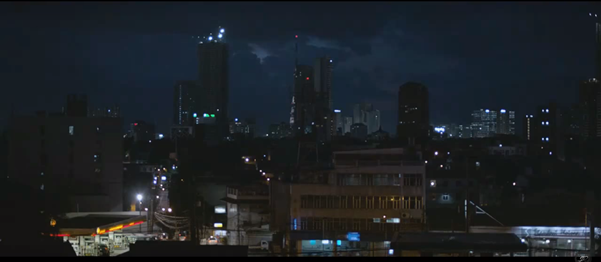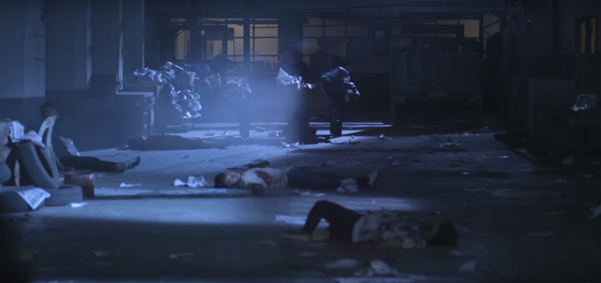
The Blurred Genres of Filipino Cinema
by Bertie Harrison-Broninski | May 1, 2020
The corrupt congressman stumbles through the garbage in the rain, hurls a briefcase of money into the heart of the landfill, and looks around anxiously for the body of his child. “Open your eyes, and you’ll see her,” says the avenging citizen, looking on from above.
I first watched Graceland in November 2019, back when no one could have imagined that the megalopolitan bustle of Metro Manila would soon be stilled in a state of lockdown. At the time, I was writing about a new wave of Filipino (and Filipino-American) crime literature termed ‘Manila Noir’ by Jessica Hagedorn, in her 2013 anthology of the same name. ‘Noir’ films and books tend to portray a cynical, urbanised society in which everyone is guilty of something; I was writing about how rubbish often serves in this new literature as a metaphor for the buried trauma of a world being eroded by unregulated development and environmental damage. Children’s corpses are found in the same landfill site that killed hundreds in a garbage landslide, in a novel about institutional sexual abuse (Smaller and Smaller Circles). The discarded bodies of birds killed by the construction of a shopping centre are deposited in Louis Vuitton bags (Aviary). Lots to unpack, but you get the idea: in a society where globalised capitalism is operating at its worst, the human and environmental cost of systemic violence is only visible in what’s left behind or thrown away.

For me, this scene of a congressman, symbolically searching through the refuse of his city, confirmed Graceland as a quintessential example of ‘Manila Noir’. Director Ron Morales had already aligned himself with this in 2013, but believed that the term ‘noir’ would be unfamiliar and therefore, unmarketable for films in the Philippines. Yet the years following Graceland saw numerous neo-noir Filipino thrillers, notably Metro Manila by Sean Ellis (2013) and Erik Matti’s action-packed movies On The Job (2013), Honor Thy Father (2015), and BuyBust (2018). This trend shows no sign of slowing down, with upcoming films like Morales’ A Violet Night, demonstrating the same moody Manila-by-night aesthetic, and even with burning piles of trash in the case of the trailer for Alyx Ayn G. Arumpac’s Aswang.
Looking online, it seemed that even if Morales’ concerns about the unmarketability of ‘noir’ had been true, when he made the statement back in 2013, this had changed in the years that followed. A trailer for Veronica Velasco’s Nuuk in November 2019 bore the tagline “a classic noir mystery”, and numerous reviews of Mikhail Red’s film Neomanila explicitly discuss its treatment of the ‘noir’ genre. Many of these movies blur the lines between what Hollywood would classify as ‘arthouse’ and ‘blockbuster’ and streaming sites are starting to snatch them up, signalling a new level of international exposure for some of these filmmakers. Graceland is on Amazon Prime and Netflix has several titles directed by Red, who’s rapidly becoming one of the country’s leading directors, despite still only being in his twenties. Erik Matti, too (along with several others), has titles available on both platforms.
The success of Filipino noir invites parallels with the South Korean film industry in the noughties, which gained a new level of intercontinental attention when its own stylistic reinvention of neo-noir, Park Chan-wook’s Oldboy, won the Grand Prix at Cannes in 2004. In 2018 South Korea surpassed India in box office revenue to become the fifth largest film market in the world, a rise to prominence set in stone this year with the Oscar-hoarding success of Bong Joon-ho’s Parasite.
Filipino media doesn’t seem to think that ‘Manila Noir’ is headed in that direction though: it’s generally pretty downbeat about the quality of its own film industry. The Manila Times responded to Parasite’s awards with an article entitled ‘Filipino filmmakers need to elevate their game’, for example. And while I’ve been cherry-picking films that neatly parallel ‘Manila Noir’ literature in their cynical depictions of urban wastelands (or waste-lands), to engage in discussions around genre in Filipino cinema is actually to enter pretty contentious waters. In 2019, director Erik Matti made national news with complaints over the domestic film industry being “in a state of coma”, and genre was at the centre of his criticism: “Everyone wants to discover a new genre or sub-genre but there’s not much reimagining that goes into it. We mostly get fast and easy genre stories with old and told character arcs and plots.” In true noir style, Matti proclaimed: “We are all guilty.”
Resisting pretentious discussion of what originality means and how we can distinguish influence from ‘rehash’, in truth this concern is far from unique. Just as it sometimes feels as though the English film industry merely churns out a never-ending stream of middle-class-grandparent-friendly-jingoism, or as though Hollywood’s franchise addiction has reached chronic levels and requires an intervention, Matti was expressing legitimate frustration with Filipino “rehashed love triangles” and “cliche children stories and old age stories”. However, Matti also touches upon something that does, I believe, distinguish the current Filipino industry from others: a conscious effort on the part of directors to blur genre boundaries. If Manila Noir is a valid categorisation, it’s important to place it within this context.

I was first confronted with this evident generic experimentation with Birdshot, another film written and directed by Mikhail Red. After beginning with an ominous shot of a bus turning a corner on a rural road at night, silhouette heads bobbing, this quick foreshadowing cuts to a gradual sunrise over hills and rice fields, before we meet our protagonist Maya (Mary Joy Apostol), having a shooting lesson. “Take a deep breath,” says her father (Ku Aquino), “choose your target, and stay on it. Find an angle…slowly…”
The early drama in the film revolves around Maya accidentally killing a Philippine eagle, which is not only endangered but the country’s national bird, and so police come knocking. Despite being set in the countryside rather than the sprawling megalopolis of the sixteen cities that compose Metro Manila, there are still traces of the world and messaging of Neomanila or Graceland. Scenes in the police office at night, with slow pans from rain on the blinds down to Officer Domingo (Arnold Reyes) smoking in the darkness, are as in-keeping with ‘original’ Hollywood film noir as ‘Manila Noir’.
The setting of the forest reserve only partially removes the ambiguous morality that accompanies Manilan characters in the other films I’ve mentioned, as it ultimately acts as a quasi-Edenic setting, in which the characters each become corrupted. There are no landfills here, but (spoiler alert!) there is still a remarkable example of confrontation with societal trauma through discarded corpses, in a shocking reference to The Maguindanao massacre of 2009 – a mass-murder resulting from staggering levels of political corruption, considered the single deadliest event for journalists in world history.
Although familiar generic pointers are present, the journey Red takes us on is not just a noir-y detective story relocated to a national park; it’s also a coming-of-age film, a shoot-out movie complete with full Mexican standoff, and even scenes that push hallucinatory magical realism just to the brink of horror, before pulling back into seeming normality.

I managed to reach Red for an interview over email, and I asked him how and why he conceived a film that crossed so many traditional genre boundaries. “It is made up of fragments of things that disturb me,” he responded, “like real news events and accounts of injustices, and also fragments of things that inspire me like the beauty of our national bird, the beauty of our countryside and the films that I loved growing up.” ‘Real news events’ doesn’t just refer to the Maguindanao massacre, but also to the story of Kagsabua, a three-year-old Philippine eagle that was shot and then eaten by a farmer in July 2008 only a few months after it had been released.
The film “is also a bird’s eye view of everything wrong with our country,” continues Red, “a parallel story of systemic corruption and corruption of our most primal form, the loss of innocence. It is both a dream and a nightmare for me and the balance of violence and beauty is what drives Birdshot. It is basically a collage of ideas that took years to manifest and form and suddenly snap into a feature-length film idea.”
Finding inspiration from the news is a common feature of Manila Noir, especially when highlighting moral ambiguity or systemic corruption; the stories in Hagedorn’s anthology are littered with nods towards real-life murders, prostitution rings, and dodgy development projects. Red clearly works similarly; in an interview with Rappler last year, he described how Neomanila was inspired by a BBC interview with a young mother who began carrying out contract killings during President Duterte’s government-sanctioned war on drugs. Erik Matti’s BuyBust is centred on similar themes: A Buy-Bust operation is a form of drug-raid, and Matti’s film depicts a revolutionary riot of slum dwellers sick of violence from the drugs war.
As mayor of Davao, Rodrigo ‘The Punisher’ Duterte enabled and encouraged extrajudicial killings of potentially thousands of drug users and street children. During his 2016 Presidential run, he promised to kill 100,000 ‘criminals’ within his first six months of office. He probably did not manage to kill that many (typical estimates put the current death-count at some 27,000), but his commitment to trying has maintained his apparent national popularity. Even the coronavirus lockdown hasn’t stopped the death count from rising: “Don’t be President if you can’t kill,” Duterte said in March.
I ask Red how important he sees the political climate of the Philippines in shaping his creative process and generic experimentation. “It has basically moulded me as a person, an artist, and is definitely ingrained in my work,” he writes. “There have always been political undertones [in his work], sometimes wrapped within a genre shell. My Netflix Original film Dead Kids is a good example because it is a critique of the youth, but it is made for the youth. I had to make a film about the perspective of the privileged and examine their psyche and how they clash with social realities they’ve ignored their whole lives, and yet I had to make sure the film is exciting, thrilling, hip, and accessible so I can get my message to those who need to hear it.
“I hate preaching to the choir, and I want to smuggle my subtext and make sure it lands on a wide audience. I don’t want to wake the woke, I want to wake those who are asleep, or on the fence, I believe that’s how real change starts. That’s why I use genre as the vehicle, and sometimes utilize studio machinery to reach the masses.”
Open your eyes, and you’ll see her. Most of the films and books I’ve viewed as Manila Noir probably do not “smuggle” their subtext to the extent that Birdshot does – but there is definitely an emphasis on ‘waking’ the complicit or ignorant to the injustices that they participate in. At a glance Red seems to have ditched the noir genre completely for his latest film, Block Z – hailed as the Philippine’s first big budget zombie flick. There’s no better opportunity to confront the process of humans becoming material waste than a zombie film though, and some of the eerily lit shots in the trailer suggest echoes of the noir aesthetic – but is he still setting out to wake the sleeping?

“Every project has a different set of objectives,” he writes, admitting that more commercial projects are different from more personal creations. Even Block Z has some Philippine genre experimentation, though: “I made sure the film had elements and combined genres that are uniquely Filipino like the Youth-oriented barkada bond, and the overseas Filipino-worker-parent angle. It also deals with school dynamics, and disparity of social class and abuse of power. Without spoiling anything, there is also a new zombie mechanic that has a lot to do with our climate and archipelago geography as a country.”
One of the aspects of Manila Noir as defined by Hagedorn that contradicts what is considered ‘traditional’ Hollywood film noir is its potential for supernatural involvement: the most unorthodox addition to her anthology is a short graphic novel whose protagonist is a supernatural detective, charged with keeping evil spirits under wraps in Manila. On-screen Filipino noir has largely remained untouched by the supernatural. That is set to change – not only with Alyx Ayn G. Arumpac’s Aswang movie, but also with Mikhail Red’s next project. He’s been commissioned to direct the third series of Halfworlds, a show for HBO Asia that revolves around an underground society populated by demons from Asian folklore – each series is set in a different city, using different local folklore (past series have been set in Jakarta and Bangkok).
“With Halfworlds we were given the freedom to independently develop our own season,” Red tells me, of the new series set in Manila. “You can watch Season Three on its own and it will still hold its narrative strength, because it deals with a uniquely new breed and myth – the Engkantos. We incorporated Filipino folkore like the Aswang, Manananggal, Tyanaks and weaved them into a story that deals with the dynamics and power struggles of our third-world society.”
I also spoke briefly with Raymond Red, Mikhail’s father and an acclaimed film director and producer in his own right. His career emerged from the Philippines’ first ‘true’ alternative film scene, when martial rule in the 1970s had required an ‘underground’ context. “During that time alternative or ‘underground’ cinema was hardly recognised, but those early efforts put focus on the possibilities of a different direction for cinema,” he tells me. “Government and private institutions soon gave recognition. Fast forward to today, and new technology both for making films as well as exhibiting them truly has opened doors for the next generation.”
When I first drafted this article, I concluded by saying that we should make the most of the Netflix era despite all its faults, and that we never know what political developments could affect the future of Filipino cinema. Since then, the world has been changed irreparably by the coronavirus pandemic. Among countless other impacts of the crisis, we’re all more dependent on Netflix than ever, and lockdown is intensifying Duterte’s already terrifying push for authoritarianism. It’s not only drug users who can be publicly shot on sight now, but simply residents who break lockdown, and outlets are already making comparisons to the 1970s martial rule Raymond Red referred to.
Increasing streaming numbers won’t save those lives, but they might help get the Philippines to the Oscars next year – if we have an Oscars next year – you never know. So next time you’re scrolling through Netflix with the family for a film or looking for a new series to start, save the agonising squabble and take a chance on Birdshot, or the new series of Halfworlds.∎
Words by Bertie Harrison-Broninski. Art by Sasha LaCômbe.




